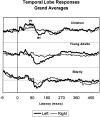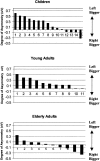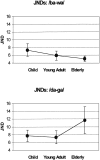Aging affects hemispheric asymmetry in the neural representation of speech sounds
- PMID: 10632608
- PMCID: PMC6772399
- DOI: 10.1523/JNEUROSCI.20-02-00791.2000
Aging affects hemispheric asymmetry in the neural representation of speech sounds
Abstract
Hemispheric asymmetries in the processing of elemental speech sounds appear to be critical for normal speech perception. This study investigated the effects of age on hemispheric asymmetry observed in the neurophysiological responses to speech stimuli in three groups of normal hearing, right-handed subjects: children (ages, 8-11 years), young adults (ages, 20-25 years), and older adults (ages > 55 years). Peak-to-peak response amplitudes of the auditory cortical P1-N1 complex obtained over right and left temporal lobes were examined to determine the degree of left/right asymmetry in the neurophysiological responses elicited by synthetic speech syllables in each of the three subject groups. In addition, mismatch negativity (MMN) responses, which are elicited by acoustic change, were obtained. Whereas children and young adults demonstrated larger P1-N1-evoked response amplitudes over the left temporal lobe than over the right, responses from elderly subjects were symmetrical. In contrast, MMN responses, which reflect an echoic memory process, were symmetrical in all subject groups. The differences observed in the neurophysiological responses were accompanied by a finding of significantly poorer ability to discriminate speech syllables involving rapid spectrotemporal changes in the older adult group. This study demonstrates a biological, age-related change in the neural representation of basic speech sounds and suggests one possible underlying mechanism for the speech perception difficulties exhibited by aging adults. Furthermore, results of this study support previous findings suggesting a dissociation between neural mechanisms underlying those processes that reflect the basic representation of sound structure and those that represent auditory echoic memory and stimulus change.
Figures






References
-
- Alho K, Sams M, Paavilainen P, Reinikainen K, Naatanen R. Event-related brain potentials reflecting processing of relevant and irrelevant stimuli during selective listening. Psychophysiology. 1989;26:514–528. - PubMed
-
- Alho L, Woods D, Algazi A, Naatanen R. Intermodal selective attention. II. Effects of attentional lead on processing of auditory and visual stimuli in central space. Electroencephalogr Clin Neurophysiol. 1992;82:356–368. - PubMed
-
- Amenedo E, Diaz F. Effects of aging on middle-latency auditory evoked potentials: a cross-sectional study. Biol Psychiatry. 1998;43:210–219. - PubMed
-
- Auerbach SH, Allard T, Naeser M, Alexander MP. Pure word deafness. Analysis of a case with bilateral lesions and a defect at the prephonemic level. Brain. 1982;105:271–300. - PubMed
Publication types
MeSH terms
Grants and funding
LinkOut - more resources
Full Text Sources
Medical
